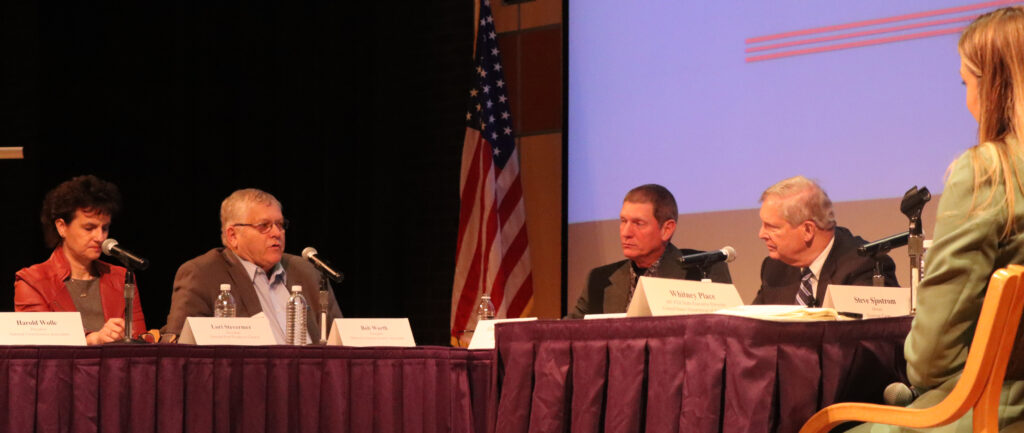The Environmental Protection Agency (EPA) is required to review active ingredients in crop production every 15 years. The pyrethroid class of insecticides is due for review in 2017, putting the future of critical bifenthrin insecticides in peril.
“Here in the United States, we’ve always embraced the idea that there are risks and benefits with products,” says Dr. Joe Bischoff of Cornerstone Government Affairs, “and we have to look at them both to determine if we go forward with them or not.”
In November 2016, the EPA delivered an overly conservative preliminary risk assessment, says Rick Kesler, FMC’s industry relations manager.
“It was a very simplistic, incomplete and unbalanced risk assessment,” Kesler told Minnesota soybean leaders. “They didn’t include a lot of their own data, they didn’t include most of the data that the pyrethroid working group presented to them. What we want them to do is go back and give a much more complete and robust review.”
Pyrethroids are applied on about 4 million acres in Minnesota and 50 million acres in the United States. Bifenthrin is the country’s most common pyrethroid, used on more than 14 million acres nationwide and nearly a million acres in Minnesota alone. Numerous food crops, including corn and soybeans, are among the crops in United States that bifenthrin protects from pests.
“Bifenthrin gives growers an alternative mode of action,” Kesler says. “Pyrethroids are still fairly low-cost — we start losing this, then we start to lose not only an effective tool, but also one that is a lower-cost option.”
There is vocal opposition to pyrethroids, primarily in California. Before the EPA can deliver its final assessment, they need equally vigorous input from farmers and other agricultural stakeholders.
“The group in California is absolutely reaching the EPA with their concerns and their own studies,” says Lisa Smith of FLM+. “That dynamic is creating some of the urgency for the pyrethroid working group, so we need to balance out what the EPA is already hearing from the opposition in California and other parts of the country.”
Through March 31, Minnesota farmers will have their chance to speak up and express the importance of bifenthrin as a pest management tool. Kesler expects the EPA to announce its mitigation measures and label restrictions by the end of 2017. A second comment period will follow, and any possible restrictions will likely be applied by 2019.
“This is the time to really get involved,” Kesler said. “If we don’t, they could put a lot more mitigation on these products is what might happen. It’s not a witch hunt, but once they announce their restrictions, it gets harder and harder for the EPA to back away from that.”
The quickest route to submitting comments is via defendbifenthrin.com, where proponents of the pyrethroid can directly express their concerns to the EPA.
“You may not use bifenthrin every year on every acre,” says MSGA Director Earl Ziegler, “but the EPA needs to know you need this tool in the tool box.”
Kessler doesn’t expect the EPA to remove bifenthrin from the marketplace — “that would be the worst-case scenario,” he says — but he would like to see the agency use sound science and utilize all the available resources.
“They do a lot of computer modeling instead of real-world data,” he says. “We need to get involved. If we don’t get involved, they could put a lot more mitigation restrictions than are necessary.”Bischoff says despite the vows of Scott Pruitt, the new head of the EPA, to roll back some regulations, proponents of bifenthrin should maintain vigilance in defending its use. Waiting for de-regulations isn’t the solution, he says.
“We are seeing a shift at the EPA with conversations around climate policy, and those regulations are going to be re-evaluated,” Bischoff says. “But this is going to be a long-term process. In pesticide policy, there is guidance and there are models in place that have been put in place over many years. Reversing that, or putting us back to where we were before, is going to take a lot of time.”
Farmers are encouraged to visit defendbifenthrin.com, and detail how they use bifenthrin on their operation and the setbacks they would face if access to bifenthrin was restricted. The website also has tips on how to best effectively communicate how bifenthrin fits into farmers’ resistant management plans.
“It’s an incomplete assessment. Period,” says Brown County farmer and MSGA Director Steve Commerford. “They didn’t do their job, and we need to let the EPA know that.”






